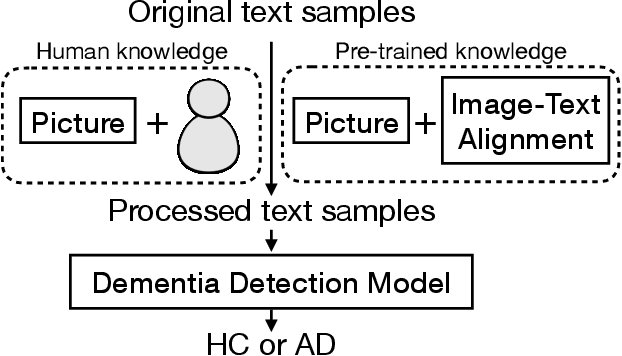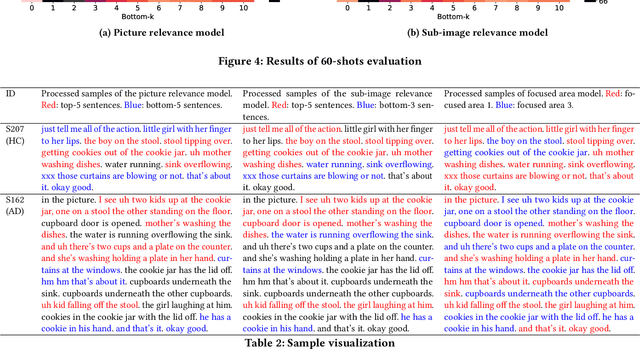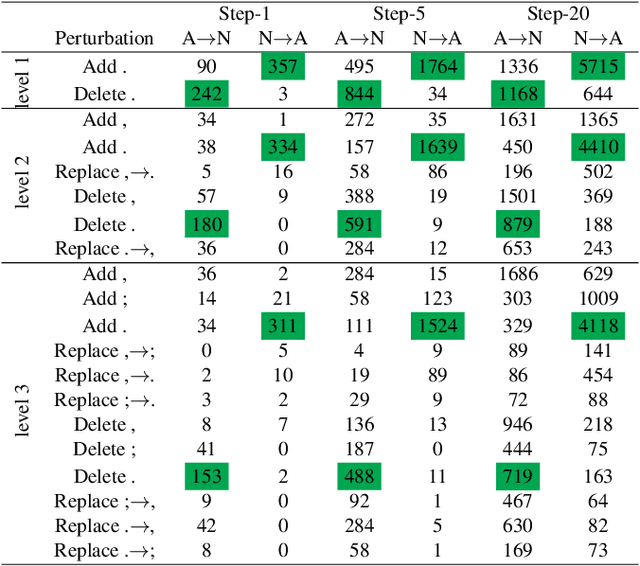John A. Batsis
Analyzing Multimodal Features of Spontaneous Voice Assistant Commands for Mild Cognitive Impairment Detection
Nov 06, 2024Abstract:Mild cognitive impairment (MCI) is a major public health concern due to its high risk of progressing to dementia. This study investigates the potential of detecting MCI with spontaneous voice assistant (VA) commands from 35 older adults in a controlled setting. Specifically, a command-generation task is designed with pre-defined intents for participants to freely generate commands that are more associated with cognitive ability than read commands. We develop MCI classification and regression models with audio, textual, intent, and multimodal fusion features. We find the command-generation task outperforms the command-reading task with an average classification accuracy of 82%, achieved by leveraging multimodal fusion features. In addition, generated commands correlate more strongly with memory and attention subdomains than read commands. Our results confirm the effectiveness of the command-generation task and imply the promise of using longitudinal in-home commands for MCI detection.
Exploiting Longitudinal Speech Sessions via Voice Assistant Systems for Early Detection of Cognitive Decline
Oct 16, 2024Abstract:Mild Cognitive Impairment (MCI) is an early stage of Alzheimer's disease (AD), a form of neurodegenerative disorder. Early identification of MCI is crucial for delaying its progression through timely interventions. Existing research has demonstrated the feasibility of detecting MCI using speech collected from clinical interviews or digital devices. However, these approaches typically analyze data collected at limited time points, limiting their ability to identify cognitive changes over time. This paper presents a longitudinal study using voice assistant systems (VAS) to remotely collect seven-session speech data at three-month intervals across 18 months. We propose two methods to improve MCI detection and the prediction of cognitive changes. The first method incorporates historical data, while the second predicts cognitive changes at two time points. Our results indicate improvements when incorporating historical data: the average F1-score for MCI detection improves from 58.6% to 71.2% (by 12.6%) in the case of acoustic features and from 62.1% to 75.1% (by 13.0%) in the case of linguistic features. Additionally, the prediction of cognitive changes achieves an F1-score of 73.7% in the case of acoustic features. These results confirm the potential of VAS-based speech sessions for early detection of cognitive decline.
Evaluating Picture Description Speech for Dementia Detection using Image-text Alignment
Aug 11, 2023



Abstract:Using picture description speech for dementia detection has been studied for 30 years. Despite the long history, previous models focus on identifying the differences in speech patterns between healthy subjects and patients with dementia but do not utilize the picture information directly. In this paper, we propose the first dementia detection models that take both the picture and the description texts as inputs and incorporate knowledge from large pre-trained image-text alignment models. We observe the difference between dementia and healthy samples in terms of the text's relevance to the picture and the focused area of the picture. We thus consider such a difference could be used to enhance dementia detection accuracy. Specifically, we use the text's relevance to the picture to rank and filter the sentences of the samples. We also identified focused areas of the picture as topics and categorized the sentences according to the focused areas. We propose three advanced models that pre-processed the samples based on their relevance to the picture, sub-image, and focused areas. The evaluation results show that our advanced models, with knowledge of the picture and large image-text alignment models, achieve state-of-the-art performance with the best detection accuracy at 83.44%, which is higher than the text-only baseline model at 79.91%. Lastly, we visualize the sample and picture results to explain the advantages of our models.
Towards Interpretability of Speech Pause in Dementia Detection using Adversarial Learning
Nov 14, 2021



Abstract:Speech pause is an effective biomarker in dementia detection. Recent deep learning models have exploited speech pauses to achieve highly accurate dementia detection, but have not exploited the interpretability of speech pauses, i.e., what and how positions and lengths of speech pauses affect the result of dementia detection. In this paper, we will study the positions and lengths of dementia-sensitive pauses using adversarial learning approaches. Specifically, we first utilize an adversarial attack approach by adding the perturbation to the speech pauses of the testing samples, aiming to reduce the confidence levels of the detection model. Then, we apply an adversarial training approach to evaluate the impact of the perturbation in training samples on the detection model. We examine the interpretability from the perspectives of model accuracy, pause context, and pause length. We found that some pauses are more sensitive to dementia than other pauses from the model's perspective, e.g., speech pauses near to the verb "is". Increasing lengths of sensitive pauses or adding sensitive pauses leads the model inference to Alzheimer's Disease, while decreasing the lengths of sensitive pauses or deleting sensitive pauses leads to non-AD.
 Add to Chrome
Add to Chrome Add to Firefox
Add to Firefox Add to Edge
Add to Edge